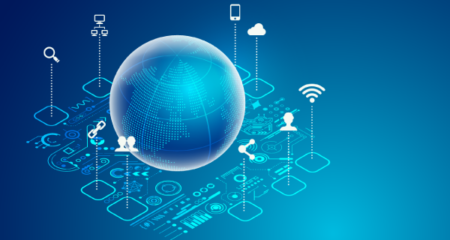How to Support Employees
and Stay on Track
with a Fully Remote Workplace
and Stay on Track
with a Fully Remote Workplace
Lessons from the Chief People Officer
This post was originally published by Suzanne Rudnitzki on LinkedIn.
For many organizations, the reality of a fully virtual workforce is here. Just last week we posted a blog about how to prepare for this change, and now we’re seeing what that truly looks like in practice.
As the Chief People Officer at Smarsh, it is my job to support our staff so they can be healthy, enthusiastic drivers of the company’s mission. That responsibility weighs heavily on me now more than ever. The COVID-19 epidemic has been and will continue to be an unprecedented challenge for all HR leaders. Employees look to us for guidance in these uncertain times.
Whether your team is typically remote, or temporarily remote, shifting to the at-home work model is more than just having the appropriate equipment for employees to do their jobs. It is also about sharing instructions for the right environment, appropriate etiquette and day-to-day guidelines that will make the transition as seamless and collaborative as possible. Communicating with team members in the early stages of virtual working set a critical standard for expectations.
The impacts of this crisis will be substantial and ongoing. However, with the right mix of preparation and cross-functional collaboration, it can be an opportunity to strengthen your organizational resolve. Prioritizing operational consistency, technology support and working together will enable employees to continue doing what they do best.
To my fellow HR leaders—this moment, while challenging, is also a chance to optimize the work experience for your whole organization. Here are a few tips for implementing remote-work best practices that will serve your company today and in the future:
Keep up to date on the most current and reliable information. This is specific to the global situation we’re experiencing now. At Smarsh, we’ve been continually referencing credible international health organizations like the CDC and WHO for updates. We recommend regularly sharing that information with your teams and sending them directly to the appropriate source. There is also a global dashboard that has been widely shared, with up-to-date numbers of confirmed cases and locations of the COVID-19 virus here: https://ncov2019.live/data
Have a plan of action and encourage over communication during this time. We began regularly communicating updates on the coronavirus in February, when the threat was starting to reach an international crisis level. This gave our staff time to prepare and our leaders the chance to answer questions or field them to the appropriate person/team. We also shared guidance about working from home, even before we were sure it would be necessary across the board. Setting ground rules early on ensures that every team is set up for success, even if it seems like information they already know.
Now that we’ve gone fully remote, over communication is even more crucial. Over communicate about over communicating. Regular meetings over video and discussions about what’s working and what isn’t will go a long way toward keeping everyone feeling supported and on the same page. Here are some questions that managers can use to facilitate these conversations:
- How can we continue to foster a sense of community and collaboration while away from the office?
- What do you all need to do your best work from home?
- How can I support you best during this time?
Prioritize technology and your tech support staff. There are so many collaboration, conferencing and messaging tools (like Microsoft Teams, Slack or Zoom) available today. What’s important is to agree on the tools your organization will be using and how they should be used. And new tools pop up every day. Whatever this configuration looks like for your company, make sure employees adopt the standard tools and are trained to use them.
This is also a good time to give some extra care to your IT and information security teams, who are sure to be feeling added pressure while people are working remotely. They have to consider the concerns and risks involved with a scaled-up remote operation, such as network bandwidth and security, and how to make sure people are working productively and securely in their home environments. Help them by getting their feedback and communicating technology and security best practices on their behalf.
Maintain a sense of continuity wherever possible. This is really important. Continuity provides stability for workers going through a major life event, so treat every day like a typical workday. Encourage your teams to check in throughout the day—hello in the morning, stepping out for lunch, signing off for the day. It might even be a good idea for teams to agree on a sign-on/sign off process to start and end the day.
Working from home doesn’t mean the rules have changed. Business etiquette should stay the same as it would in the office. Employees should dress appropriately, remove distractions, use active listening techniques and as always, adhere to the company’s code of conduct and ethics. In fact, in the spirit of over communication, this is a good time to recirculate the employee handbook and point out applicable sections.
Another part of this is to maintain performance and engagement monitoring as you normally would. Managers can use measurable outcomes to track employee performance (at Smarsh we employ quarterly goals) and continue regular one-on-one meetings to check progress. When it comes to monitoring engagement, look out for signs that may be cause for concern, such as slow response times, absenteeism (not illness related), or lack of participation in team meetings.
Get creative. Maintaining continuity doesn’t mean you can’t be creative. Smarsh is a growing company and we continue to onboard new employees. Microsoft Teams allows us to video chat so we can make our new hires feel more personally connected on those already precarious first days. On the all-company collaboration channel, we have begun announcing new hires so people can welcome them from wherever they are, and at any time.
Our IT team has seized a creative opportunity to finish a project that had been challenging to complete during office hours. They’d been tasked with migrating all the company printers from a network to the cloud and had to make sure all equipment was out of use to begin the process. This is much easier to troubleshoot while people are out of the office, which has had the added benefit of allowing the team to safely do their job.
Take the chance to learn about this experience from your teams. For example, at Smarsh we are introducing a new internal chat channel that we call, “lemons to lemonade,” for sharing wins that have come as a result of working in new ways. We look forward to learning how our employees have been sparking innovation under unusual circumstances.
Be flexible and trust your employees. Realize that people are personally impacted as this situation unfolds and be more tolerant. Relying on communication will be key, but rigid micro-managing of daily activities hinders productivity and can create distrust. Keep close to their work but utilize this time to build trust. Not to be forgotten—take care of yourself.
Don’t lose sight of what keeps your staff engaged—their coworkers. Virtual watercooler talk can be a healthy way for employees to blow off steam. Already we’ve had people eat their lunches together over video chat, introduce their pets to coworkers and set up virtual trivia games. I can imagine some potential remote happy hours in the future as well.
How Smarsh can help
None of this would be possible if it weren’t for the many online communication tools that are used to do business in the modern world. For organizations with compliance or e-discovery obligations, it may seem daunting to enable so many new ways of interacting. The sudden introduction or expansion of new communication tools means a major increase in volume and variety of communications data. The capture, retention and oversight of this content creates a heavy burden on IT, compliance and legal teams.
Enabling employee collaboration has never been more important, but it doesn’t have to be a burden. Smarsh has comprehensive solutions for capturing, archiving and supervising employee communications from all the channels and devices your employees need to stay connected—and keep you protected from risk. If your organization has been considering the deployment of new tools, our team of experts can guide you through that process, safely and quickly.
Smarsh has the comprehensive and scalable capture and archiving solutions to support the unprecedented challenge of moving an entire organization to a remote workplace. Let us help you turn lemons into lemonade.
More resources:
Blog: Being Strategic About a Suddenly Stay-at-Home Workforce
Webinar: How to Supervise Your Suddenly Remote Broker-Dealers & Investment Advisors
Guide: Key Considerations When Making the Move to Office 365
Guide: How to Supervise IM and Collaboration Platforms for Compliance
Share this post!
Smarsh Blog
Our internal subject matter experts and our network of external industry experts are featured with insights into the technology and industry trends that affect your electronic communications compliance initiatives. Sign up to benefit from their deep understanding, tips and best practices regarding how your company can manage compliance risk while unlocking the business value of your communications data.




Subscribe to the Smarsh Blog Digest
Subscribe to receive a monthly digest of articles exploring regulatory updates, news, trends and best practices in electronic communications capture and archiving.
Smarsh handles information you submit to Smarsh in accordance with its Privacy Policy. By clicking "submit", you consent to Smarsh processing your information and storing it in accordance with the Privacy Policy and agree to receive communications from Smarsh and its third-party partners regarding products and services that may be of interest to you. You may withdraw your consent at any time by emailing privacy@smarsh.com.
FOLLOW US